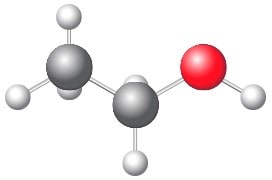Ethanol
What Is Ethanol?
Ethanol is a clear, colorless liquid with a distinct odor and a burning taste that mixes easily with water. It’s prepared by carbohydrate fermentation and acts as a central nervous system (CNS) depressant, a diuretic, and a disinfectant.
Ethanol can be found in emissions from plants, fires, volcanoes, animal wastes, and insects, and is a product of natural sugar fermentation. It’s also an important component of alcoholic beverages, many of which contain up to 50 percent ethanol.
Intoxication resulting from the ingestion of alcoholic beverages is generally attributed to ethanol content. Effects include loss of coordination and inhibition, impaired judgment, blurred vision, slurred speech, dizziness, mood changes, drowsiness, headache, increased heart rate, and nausea and vomiting.
Ingesting large amounts of ethanol can lead to unconsciousness and death. Long-term alcohol abuse is associated with liver disease and an increased risk of stroke, heart disease, and obesity. Excessive long-term use can lead to various cancers. Fetal alcohol syndrome in infants can also result when alcohol is consumed in large amounts during pregnancy.
Alcohol ultimately injures cells by dehydrating and precipitating cytoplasm or protoplasm which produces its bactericidal and antifungal properties. It binds to GABA, glycine, and NMDA receptors and modulates their effects. It’s also metabolized by the enzyme alcohol dehydrogenase.
Ethanol has not been specifically evaluated, but sufficient evidence exists to treat alcoholic beverage consumption as a human carcinogen.
Synonyms: Ethyl alcohol, absolute alcohol, methyl carbinol, grain alcohol

Physical and Chemical Properties
| Property | Value | ||
|---|---|---|---|
Molecular Weight | 46.069 g/mol | ||
Density | 0.7893 g/mL at 20ºC | ||
Boiling Point | 78.2ºC | ||
Melting Point | -114.1ºC | ||
Flash Point | 14.0ºC | ||
Viscosity | 1.074 mPa·s at 25ºC | ||
Dielectric Constant | 24.3 at 25ºC | ||
Dipole Moment | 1.66 D at 20ºC | ||
UV Cutoff | 205 nm | ||
Refractive Index | 1.3611 at 20ºC | ||
Vapor Pressure | 59.27 mm Hg | ||
Water Solubility | Miscible | ||
Heat of Combustion | 1336.8 x 106 J/kg at 25ºC | ||
Heat of Vaporization | 42.32 x 104 J/kg at 80ºC | ||
Dissociation Constant | 15.9 pKa at 25ºC | ||
Surface Tension | 21.97 mN/m at 25ºC |
Uses
Ethanol is used as a solvent, fuel additive, and in the production of pharmaceuticals, perfumes, cosmetics, and other chemicals. It is also an ingredient in consumer products like cleaners, sprays, inks, mouthwash, and aftershave.
Designations and Grades
| Property | Value | ||
|---|---|---|---|
CAS Number | 64-17-5 | ||
MDL Number | 3568 | ||
RIDAD/UN Number | UN 1170 | ||
Beilstein Registry | 1718733 | ||
EG/EC Number | 200-578-6 | ||
NSC Number | 85228 | ||
ICSC Number | 0044 | ||
RTECS Number | KQ6300000 |
Grades
ACS/ACS Reagent/Certified ACS
Biochemical
Histological
HPLC
Laboratory/Technical
NF/USP
Sequencing
Spectrophotometry
A New Way to Shop for Chemicals
Conduct your search by drawing your molecule or uploading its chemical structure.
Chemical Safety at Your Fingertips
Locate a safety data sheet (SDS) for a particular chemical or catalog number.
